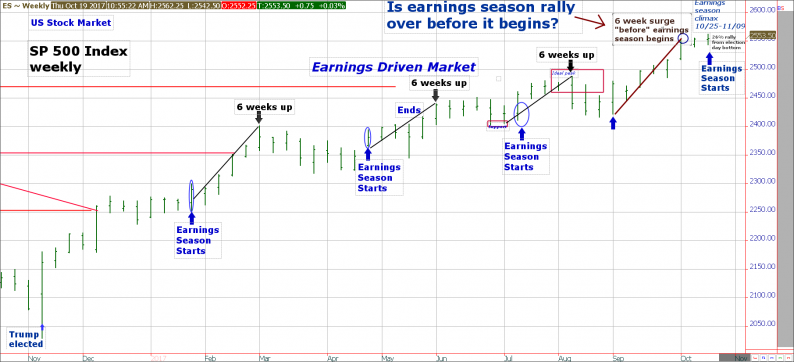A persistent theme for 2017 has been stocks surging to record highs during each quarterly earnings cycle. The first three-quarters of 2017 earnings have seen a series of 6-week explosions to the upside: February, April-May, and July. In fact, removing these three 6-week surges would leave the stock market completely flat for the year through August. The current earnings cycle is different. The predictable 6-week run to record highs this time has occurred prior to the deluge of earnings releases. Could the expected corporate profit reports have been overly anticipated, mostly reflected in the current peak?

Normally, we would look for a strong market rally to begin now and carry into late November or early December. However, with so much buying power used up before the earnings onslaught, we suspect that momentum will be waning as we move into November. Correction risk may be minimal until we get past the earnings release climax around the 2nd week of November. The surprisingly positive earnings reports by IBM and Adobe this week are examples of why it’s a fool’s errand to call a market top without seat belts. Are there areas of technical concern? Absolutely! The small-cap stocks along with sentiment measures such as put/call option ratios and CNN’s Fear and Greed Index have clear negative divergences throughout October with the major indices of the Dow and S&P 500 Index.
The sentiment is a contrarian indicator. When people are most negative, the investor selling power is exhausted and prices are ready to move higher. The converse is also “generally” true—when sentiment is extremely optimistic, buyers have exhausted their sideline cash and stocks become vulnerable to a market decline. Strong oversold sentiment put option buying extremes in early November and mid-August when investors were most bearish (blue arrows) signaled excellent buying opportunities. Calculating sell signals in “running” bull markets is more difficult. It’s common to see sentiment swing from oversold to overbought, as it did in November to December last year, but in a runaway phase of a bull market, stocks can be periodically overbought for months without a sufficient correction to create an oversold buying zone. The options trader sentiment reaction since September is interesting with the explosive move higher in stocks that coincided with increasing skepticism and put option buying when normally optimistic call buying would occur as prices move higher. Should further new highs in the stock market coincide with another dip in put/call ratios below our red line, then the odds of a correction will increase. Sentiment measures will need a deeper oversold condition like August and last November and then a new rally phase before they can be relied upon for the sell side.













Leave A Comment